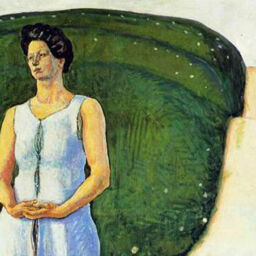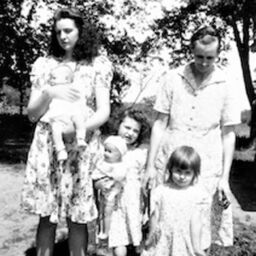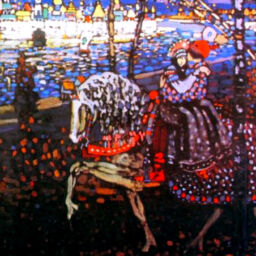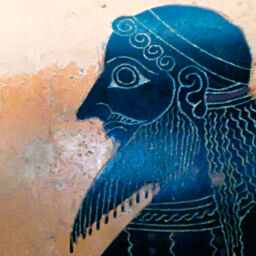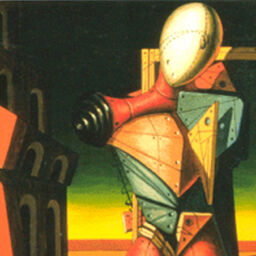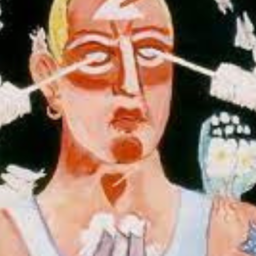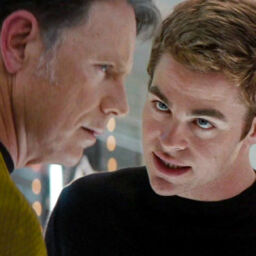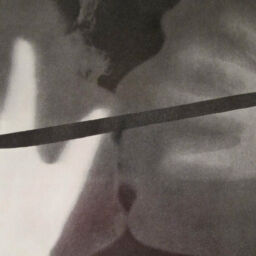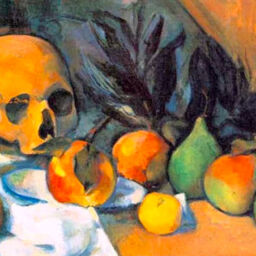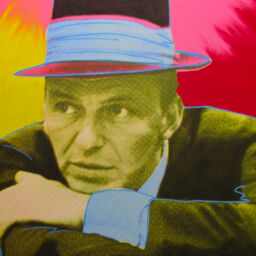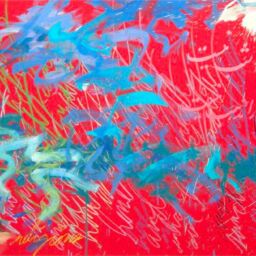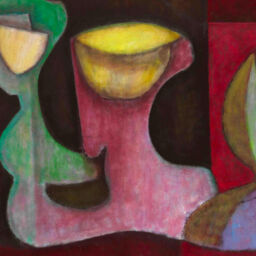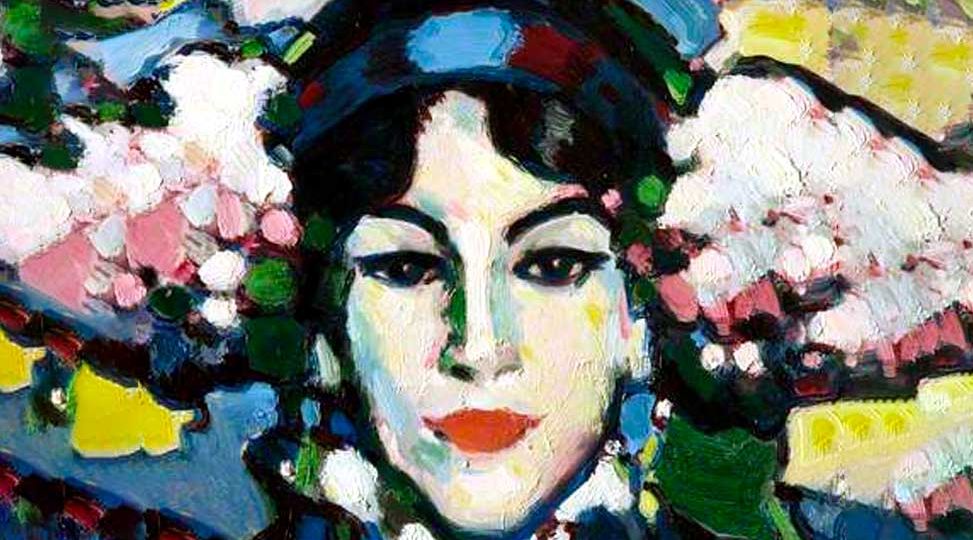
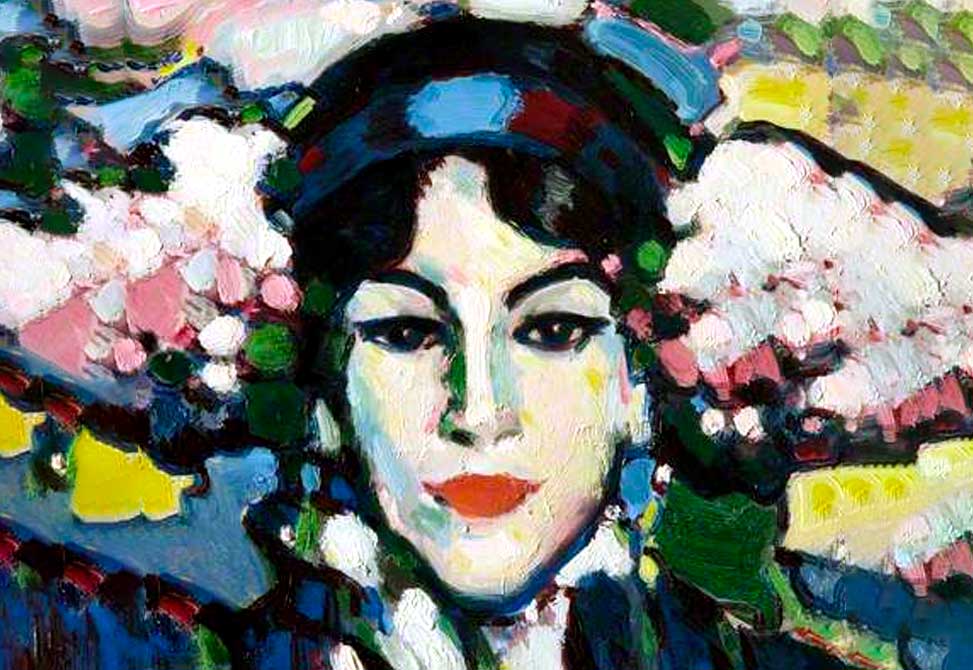
My life shifted at age 52, a time when my inferior extraverted sensation was demanding admission to consciousness. While on a leisure trip to Las Vegas, I had a clear but brief waking dream. As I was leaving my hotel room, I turned to close the door, and sitting on the bed was the image of an attractive brunette woman. It disappeared in an instant. I did not know why they mattered, but many years ago, I memorized some words written by the poet Rilke (1954):
Someday there will be girls and women whose name will no longer signify merely an opposite of the masculine, but something in itself, something that makes one think, not of any complement and limit, but only of life and existence: the feminine human being. (p. 45)
Now I know.
Jung (1952/1956) spoke about the recognition of the anima as a personified agent:
There are no conclusive arguments against the hypothesis that these archetypal figures are endowed with personality at the outset and are not just secondary personalizations. Insofar as the archetypes do not represent mere functional relationships, they manifest themselves as daimones, as personal agencies. In this form they are felt as actual experiences and are not ‘figments of the imagination’ as rationalism would have us believe. (¶ 388)
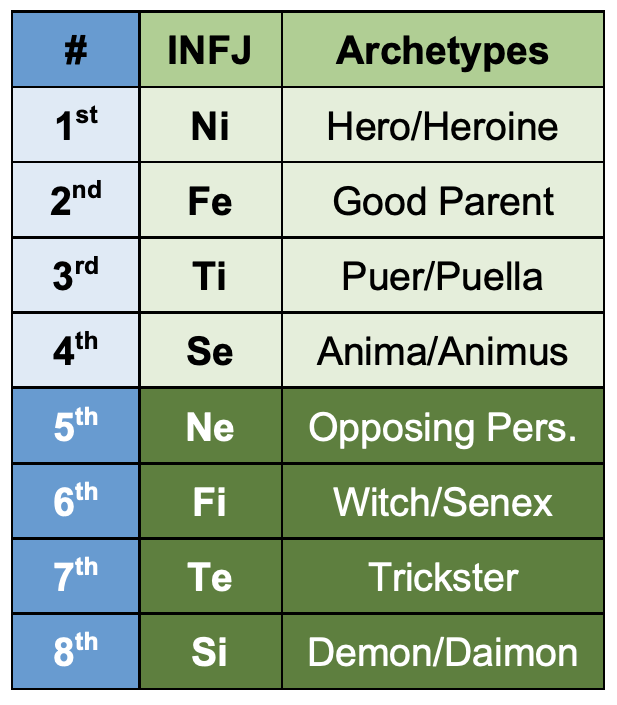
We seemingly live in a pandemic of anxiety in which self-awareness and understanding are antiquated notions smothered in an ocean of quiet desperation. Ubiquitous yet palpable anguish bombards us with a chaotic chatter. Carol Shumate (2021) said about such a confusing mien: “Those who do not know themselves cannot perceive others realistically either. They live in a bubble of delusion” (p. 13). What is one to do? Paying attention to images and instinctual emotions can help. When Jung was in crisis after his break with Freud in 1913, his ego’s defenses were inadequate, and he was thrown into the maelstrom of a profound identity crisis. Jung (1961/1963) was able to navigate this passage by identifying the images that underlay his emotions:
To the extent I managed to translate the emotions into images … to find the images which were concealed in the emotions—I was inwardly calmed and reassured. Had I left the images hidden in the emotions I might have been torn to pieces by them … I learned how helpful it can be, from a therapeutic point of view, to find particular images which lie behind the emotions. (p. 201)
My own experience shows how a personified image of an anima-derived figure can manifest and how one might come into a conscious position of alignment with the libidinous drive behind the form. My soul work has been convoluted, caustic, bloody, and full of pain and drama, but it marks a complex initiatory rite of passage ultimately leading not toward a specific goal, but to a way of embracing and living deeply into the mystery that is my life.
The Hidden Other
I was raised in West Texas within the bosom of a loving family. My parents were intelligent, supportive, hardworking people who were not afraid to display affection. Paradoxically, they were an elegant power couple living in the bardo land. We owned the grocery store that was the heart and soul of the community. But later in life, they visited Egypt multiple times. My mother had a voice that should have been trained at Juilliard, and my father read the Encyclopedia Britannica each night and made stained-glass windows for a hobby. Both sets of grandparents lived close by, and as I was the only grandchild, they doted on me. It was a lovely, almost scripted, childhood. Early on, I learned to use my auxiliary extraverted feeling (Fe) function to please others, and my dominant introverted intuition served that goal. In this way, my auxiliary function took the lead, and my dominant function served my auxiliary instead of the other way around. It took many years and much turbulence before I was able to acknowledge that the script I was living was not right for me.
At age five, I had a waking dream that seems to mark some sort of an induction—a profound experience that began with a venture into the darkness and an innocent knowing that something strong, beautiful, and beyond my known self enveloped and protected me:
Waking Dream #1: “The Chorus,” Big Spring, Texas, 1955
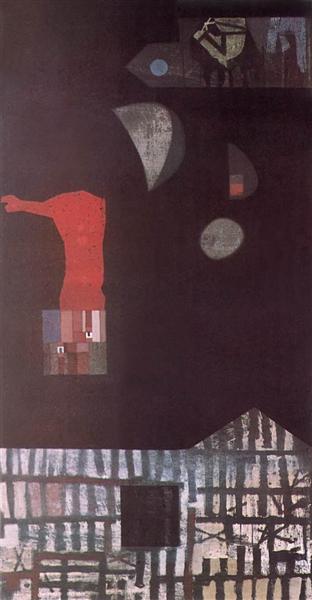
What I vividly recall is that the air was pregnant, I was never afraid, and I felt a deep longing when the music died. The bright lights in my bedroom and the dark house that I walked through imply the states of consciousness and unconsciousness. The fact that I lay in the upper bunk “where I never sleep” may symbolize the fact that I was not fully living from my natural “upper” functions, while the lower bunk, in shadow, might represent the “shadow” or egodystonic functions where I often hid from myself. That I was afraid of UFOs and dinosaurs suggests fear of what streams from the archaic and alien depths of an infinite psyche. This awareness points to at least a rudimentary exposure to the presence of Other, which correlates with the archetype of the opposing personality that carries extraverted intuition (Ne) in my INFJ typology. There is also an element of a budding dominant introverted intuition that can merge past, present, and future and accept anything as possible, including aliens, prehistoric beasts, and angelic choirs. The memory would fall back into the depths yet would always be enshrouded by a potent valence.
Jung also had a formative dream at a young age. In his crucial dream that presented near the age of four, he stepped down a shaft that led to an underground temple housing a ritual phallus propped upon a golden throne. He said many years later, “I know that it happened in order to bring the greatest possible amount of light into the darkness. It was an initiation into the realm of darkness” (Jung, 1961/1963, p. 15). In my case, I got lost in the darkness and spent the first forty-two years of my life constructing and maintaining the persona of an alpha male.
From early on, I felt the confusing but persisting urges to be a female, but I suppressed them. In the first grade, I was in a performance in which I wore lipstick and blush. I remember that I hid afterwards so that I would not have to remove the makeup. This was something “other” that hid in the depths. Instead, I used a combination of my superior and auxiliary functions, introverted intuition and extraverted feeling, to read the people around me, gauge their expectations, intuit the best response, and measure their approval. Pleasing others was how I learned to navigate the world.
My accomplishments mounted, but I did not feel fulfilled. In high school, I was captain of the football team and a finalist for the state Young Texan of the Year award. I attended a large university for one year and was elected the class vice-president. Then I was selected to go to West Point, where I was captain of the baseball team and ranked second in the Corps chain of command my senior year. Life at West Point offered a perfect matrix in which to both ground and inflate my introverted intuition and extraverted feeling, and I have warm memories of that time to this day. Despite all my accomplishments, however, I remember driving through the gates of West Point on the day of graduation thinking that somehow, I had failed. I see now that my extraverted sensing inferior function was desperately seeking a form. After graduation and Infantry commission, I received the Ranger tab and served for four years as a paratrooper. Then, not certain of a path, I went to medical school because it seemed to be another challenge, and my family supported it.
My orientation underwent a dramatic shift during the first year of medical training: I shifted to my eternal child function, introverted thinking, and from that point forward I consciously suppressed any feeling function. I remember sitting in an ethics class and consciously saying to myself: “I won’t talk in this class for the remainder of the semester.” The larger questions around life, death, and meaning were too potent to wrestle with. I thought that if I buried my feelings and their expression, their valence would dissipate. Despite such self-suppression, I earned my MD and completed exhaustive training, becoming a competent physician and then a partner in a well-regarded nephrology practice. The medical work was particularly difficult with the death and suffering of my chronically ill dialysis patients. During this time, I also met and married my best friend, and we started a family. My wife lived much of my extraverted sensation forward as she was a beautiful professional singer who debuted with the New York Pops at Carnegie Hall.
As I moved into my forties, I began to feel the advent of a worsening yet unexplained urge to drink. I found solace in strip clubs, and one day while watching a woman dancing, I thought, “I don’t want to watch her; I want to be her.” My inferior function was seeking a form with such a primitive drive that neither my wife nor these other women could possibly satisfy the libido. I suppressed that Ni-charged revelation with my drinking until I made a developmental step forward and entered treatment for substance abuse at the age of 42. Subsequently, my dormant extraverted feeling reawakened and allied itself with a quicker witted introverted thinking to guide patients more empathetically through complex illness and transition into death. As well, I could allow my introverted intuition more constructive expression, and I used it to navigate the complexities of the healing journey. However, I aggressively pursued alpha-male activities that effectively dampened the confusing but persisting urges to be a female.
First the Anima, Then the Fall
I had constructed a professional persona of calm detachment. Introverted thinking reflected in the archetypal consciousness of puer was a perfect guise for a nephrologist/critical care specialist. Shumate (2021) said this function type “brings organization to an internal structure … [and] seeks understanding above all” (p. 138). And Jung (1921/1971) said, “Because he thinks out his problems to the limit, he complicates them and constantly gets entangled in his own scruples and misgivings” (¶ 634). In my case, I was called in to see very ill people with complex acid-base or electrolyte issues; being on call was always difficult. I never learned to relax and was constantly ruminating about potential catastrophes with these horribly ill patients. The fears rarely manifested, but that did not stop the compulsivity of an overbearing and rigid introverted thinking function in “call mode.”
I also reverted to a pattern in which I recruited introverted intuition and extraverted feeling to serve in a very polished, people-pleasing mode. Now, I see, I never allowed my superior and auxiliary functions to mature and to operate independently in expression of my Self. I had learned in my first years of life that they were useful in tandem to intuit and to feel what was expected of me by my mother. Subsequently, this hypertrophic dyad became a formidable force when employed with strong and unyielding introverted thinking. My encounter with that anima image in Las Vegas began to change all that. It occurred when I was on holiday and taking a break from work. In a clear but brief waking dream, my entire life was upended:
Waking Dream #2: “The Brunette,” Venetian Hotel, Las Vegas, Nevada, 2002
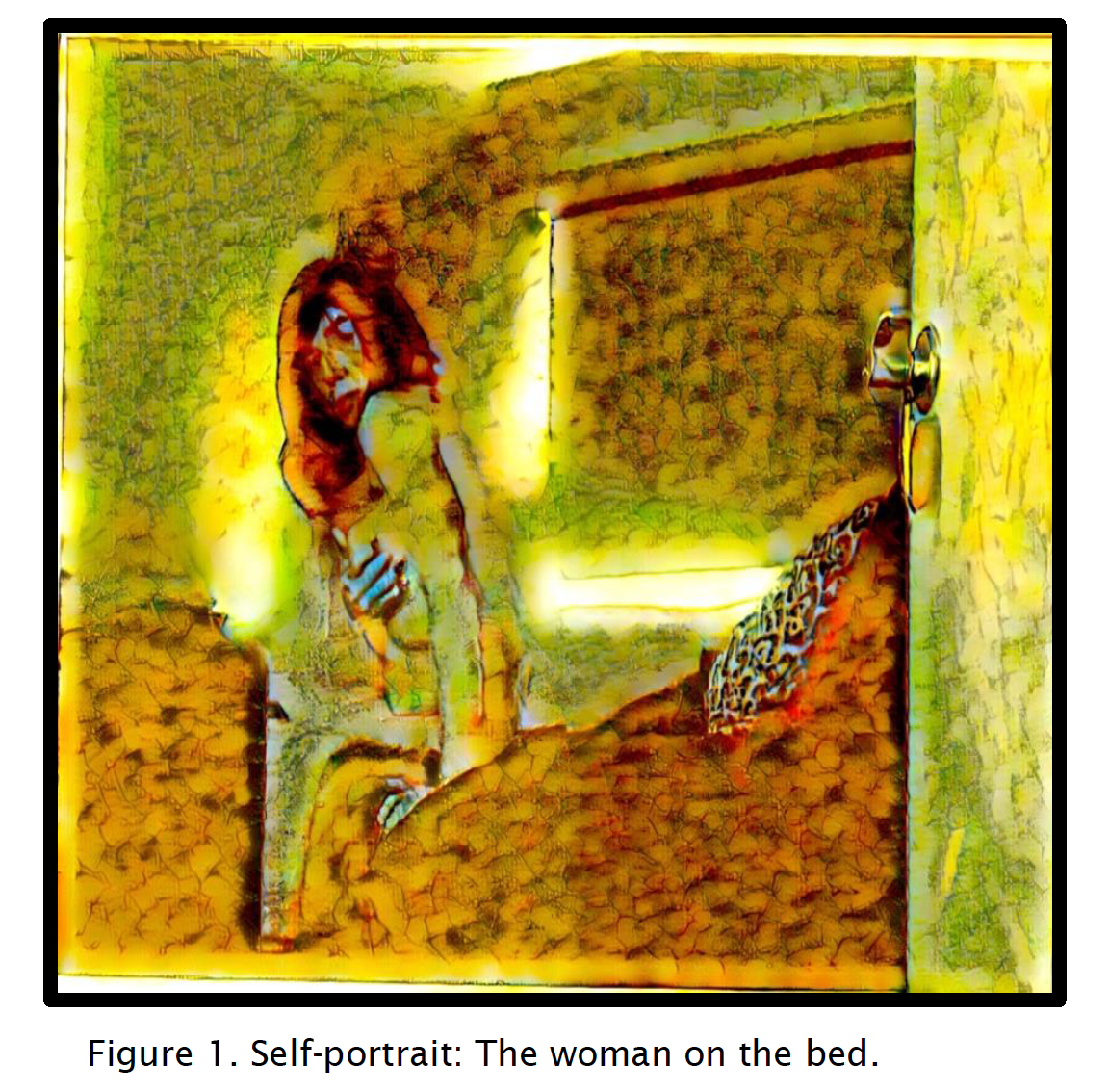
Jung saw the unfolding of anima awareness as an extraordinarily important point in the psychic maturation opus. He said of anima, “It is a life behind consciousness that cannot be completely integrated with it, but from which … consciousness arises” (Jung, 1954/1959, ¶ 57). In sum, the inferior function is the gateway to the lower realms, with anima playing the central mediatrix role. Its importance cannot be overstated; in fact, “the anima is the archetype of life itself” (Jung,1954/1959, ¶ 66). John Beebe said that extraverted sensation was Jung’s inferior function and that Salome in The Red Book is the personification of Jung’s anima. Remarkably, Jung (1935/1955) described exactly the presentation of my initial anima image when he said that “a naked anima-figure who turns her back … is a typical position” (¶ 412). Beebe’s observation that Jung’s own personal transformation was centered around his relationship with Salome is important to my own waking dream image. Its appearance in that hotel room is a turning point at which I began to feel more feminine and to become more aware of anima consciousness.
The first of the changes to come began when, at the age of 54, I left a practice and patients that I dearly loved to join a nephrologist in another town. The move was about money, which was, and is, my sleeping introverted sensing daimon. From the very start, the venture was a grueling passage. My business partner’s ISTJ personality seemed to clash with my INFJ pattern at every point. I could not see that he was someone who could teach me a great deal. The centerpiece of our collaboration was a new dialysis center which we co-owned. The plan was to build, then to sell as quickly as we could; I could then retire or move on. Almost predictably, we were unable to sell it, and the IRS placed a lien on everything I owned because we were deep in debt from the construction. In addition, we had a horrific schedule: eighteen-to-twenty-hour days were common, and I had a six-hour commute to Austin every other weekend where my wife and youngest child had moved; I was never at home in the new job, and Austin was where we wanted to retire.
One night in the last year of this drama while I was on call, I had a terrifying dream:
Dream #1: “The Executioner,” Midland, Texas, 2010
I am sitting outside of a dungeon door. I hear a guard torturing someone that I know on the other side. I am frightened but remain in place; finally, the door opens. There stands the Executioner, and he points to the floor. I realize that from the torture a silver cross has been created. I look at the bench and there is a mummy that is burning; it has been tortured, killed, and is now on fire and lifeless. Fire streams from its eye sockets.
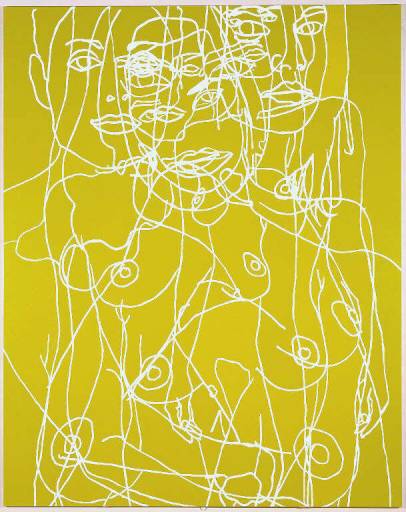
Astonishingly, miraculous circumstances ensued after seven grueling years in this crucible: two international dialysis companies got into a bidding war, and the dialysis center sold for an unimagined amount of money. I promptly retired. Perhaps my conscious heroic ego perceived the dialysis center venture as a victory, but the large sum of money that came from its sale fueled a growing self-satisfaction. The resultant hubris was noxious. It clouded any sustained growth of an anima consciousness and, as a result, blunted an awareness of shadowed lower functions that could have been mediated by the anima archetype.
Hubris as Teacher
Having received a multi-million-dollar check that enabled me to retire at age 61 and to buy a home in the Caribbean, I tackled my bucket list. I first went on a kora, a ritualized pilgrimage, around Mount Kailash, a mountain in Tibet that is sacred in multiple religious traditions. I went with an intention to discern what Life wanted from me. I then went with my youngest daughter to Uganda where we dedicated the new wing of a hospital that my family had funded. I was also shown a new protein supplement made by my Ugandan partner’s wife and pitched myself into a yearlong venture building a business to produce the supplement and to create a water bottling company. These were ventures that I had no experience in; however, I now saw myself as a rich, masculine entrepreneur who had successfully created a small fortune. The first night of my return from Uganda, I had a dream:
Dream #2: “The Ugandan Venture,” Austin, Texas, 2012
I am the head of a group that is creating new projects for Uganda. In the dream I see several floating circles and orbs; I take a photograph of people and things, and one of the orbs or circles absorbs them. The orbs are translucent, but slightly gray-tinted. I think, “I hope they all come together.” I step back and see that they all form a portion of a larger matrix; each one fits perfectly.
In this seemingly abstract, intuitive dream, I am at once trying to grasp what the future is showing while seeking to create it. However, what I do first is revelatory: I concretize the images of the orbs with a camera. They become locked in time-space and in this way lose libido. My introverted thinking is exerting itself. As well, the orbs are grey tinted, the color of brain cortex, and there is a projected desire or hope that all turns out well. Introverted thinking and extraverted feeling are both operant but in a childishly immature way.
I had used this methodology all my life, employing my superior, auxiliary, and tertiary functions in an iterative manner, but in reverse order. The childish and myopic introverted thinking plotted a course; then extraverted feeling worked like radar, always seeking to register the response of an action or reaction by someone or something. When one movement reached an apogee or the need for a change in direction, introverted intuition helped solicit the choice of another maneuver or direction. This was a dance orchestrated by a limited ego and one that had lost a sense of connection with Self, the one thing that could provide orientation. I could not fathom that Something had a grander vision, yet there was a larger picture forming. Almost inevitably, Self, seeing things much differently than ego, had a plan dissimilar to mine.
The Dark Continent: Uganda
I spent the entire next year travelling to and from Uganda, forming another company, Abundant Prosperity, Inc., with a partner, a Ugandan physician whom I had known for many years. We shared a vision to manufacture a protein supplement made from local grains and envisioned selling it to USAID, the United Nations, and the Ugandan government. Additional fantasies included constructing a water bottling plant to sell the water from a local aquifer and building a hydroelectric plant. We even had a plan for mining gold that allegedly had been discovered in the remote Ugandan region of Karamoja. Although I had no expertise, I directed the show. Often, decisions were made over the objections of my partner’s wife. Her father had been the head of the Ugandan Department of Defense, and she was a member of the Ugandan nobility. I was bathed in hubris and lost in unfamiliar psychic terrain. In this land, I could not manipulate others using the persona I had taken so many years to construct. The combined effort of my egosyntonic functions was not sufficient, and a neglected anima/animus was still in the gloaming.
After a year of work, a score of trips to Africa, and my investment of hundreds of thousands of dollars, my partner suddenly quit communicating. Several weeks went by; then late one night, while I was at my new home in Nevis, West Indies, I received a call. My partner calmly told me that he had taken all the money from our investment account and used it to run for a seat in parliament to fill a vacancy that had suddenly appeared with an unexpected death. In the blink of an eye, I lost a huge sum of money, and my visions for a future of massive wealth and prestige crashed to the ground. Then something completely unanticipated happened:
Waking Dream #3: “The Voice,” Nevis, West Indies, 2013
Sitting on the porch of our retirement home and looking at the Caribbean waves, I hear a woman’s voice say clearly, “Sheila, you are a woman and always have been. There is much work to be done.”
Despite the enormity of this fugue, I pushed it aside. I was a petulant child consumed by the loss of money and obsessing about what had transpired. I spent days calling people I knew in Uganda trying to claw back what I had lost. On one call, the partner’s wife said in a condescending tone, “You sound like a woman.” She was more correct than she could imagine.
The extraverted thinking (Te) function as trickster, in the form of my business partner, had appeared as if on cue, to augur a new life. My third function puer that I had used for years to make cool, calculating, insightful decisions was completely disoriented. Obviously, I had tricked myself with contorted thinking, and the trickster was lurking in the shadows of the unconscious. Giannini (2004) said, “The thinking function is dedicated to bringing order to the chaos of our personal and social life … . If this function becomes rigidly one-sided, one is forced to deal with … images of life and death concerns, and of raw fear, frustration, and rage” (p. 168). My extraverted thinking had slept in the dark for years; now it was aroused. Jung (1921/1971) described this perfectly when he said about extraverted thinking, which was now in a dyadic dance with a puerile introverted thinking: “The more rigid the formula, the more he develops into a martinet, a quibbler, and a prig” (¶ 685). It was the constellated trickster that shook me to the core and provided the libido to awaken something completely unknown.
The Valley of Death
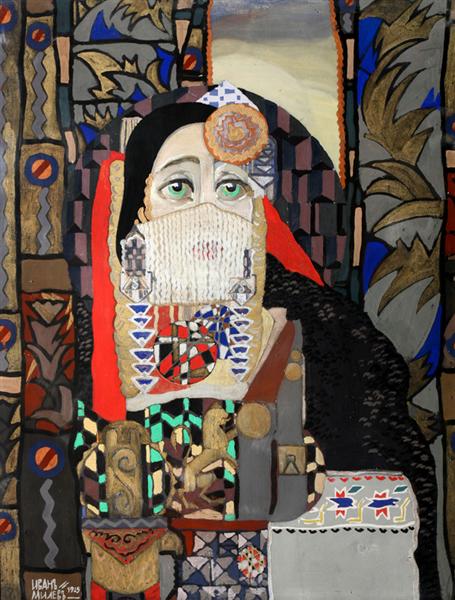
Blinded by such hubris, I was awash in soul-making, yet my ego was intransigent, scrambling to blame the loss of money and enterprise on people, places, and even the gods. Chaos flooded my psyche. A daimon disguised as pandemonium appeared, and my intellect sought to find answers or excuses using the egosyntonic functions in convoluted ways to wade through the carnage of inflated fantasies. Overwhelmed, I simply shut down. Like a sulking child, I stopped meditating and locked up my precious personal altar. I was through with the gods!
It was as if a powerful, chthonic blow to the ego had to occur to awaken me to the radical call to be “Sheila.” The events in Uganda and my waking dream on the porch in Nevis happened almost simultaneously. These life-changing experiences marked a point of departure for a journey into a strange bardo that would last for several years. Specifically, during this time I felt as if something alien had erupted deep in my psyche. Something cosmic had called me “Sheila,” a name that seemed distantly familiar, but one I could not consciously place. I felt lost and alone. Although still living with my wife, I was unable to communicate what I was feeling, especially around gender issues.
I then began to experience dysphoria, the feeling of an existential pain caused by a discontinuity of gender identity and gender expression: in other words, the interior identity of gender does not align with that of the persona. This is the realm of introverted sensation, my most unconscious function. It is also the sphere of Eris, goddess of chaos. Hesiod said that chaos was the condition from which everything emerged. Chaos might be viewed as a matrix in which every point exists in a state of opposition. This is the realm in which anima can function as mediatrix, but I had no fluency with that agency. Like Persephone, I had been dragged into the underworld.
In the darkness of that period, my egosyntonic functions became more and more dysfunctional. For so long they had triangulated movement in the egoic realm in a coordinated if pedestrian way. The dance was repeated over and over, requiring great energy to repress the screaming pleas of an anima in stasis. The lower functions were always projected, and the response to those projections set off another cycle. In this robotic and inauthentic posture, shame was a residue. I see now that the soul screams not only about fear of death but also about the horror of a life smothered in indolent lethargy. No wonder I was always deathly tired. The orchestration of my hypertrophic persona required enormous libido.
This was the nigredo foretold by the dream of the executioner. My trickster bubbled to the surface of the cauldron and sponsored ideas that could reorder my life, my finances, and my spiritual practices in a rational manner, yet the trickster seemed to know that its farcical and primitive solutions would find in me a pocket of deep resistance. This place of resistance was the last stronghold of a pilgrim soul who could feel the sadness of such inauthenticity. I went to Nevis and planned to commit suicide there.
Waking Dream #4: “The Call,” Nevis, West Indies, 2014
Standing under a harvest moon in autumn 2014, the night before my planned death, I heard the voice that had spoken to me on the porch in 2013 say clearly: “Do what you want, but there are others who need your help who will suffer if you kill yourself.”
This was an intervention that I could not explain. I see it now as a voice rumbling out of the depths of that most alien function, introverted sensation. Beebe (2004/2017) said, “To the degree that the inferior function has not been taken up as a problem by the individual in the course of development of his consciousness, it is no match for the demonic aspect of the unconscious” (p. 46). Introverted sensation, functioning to monitor the internal environment and focus on a past that had been shaped by West Point, tradition, and alpha-male aggression, would fuel the eruption of chaos by reminding me of these simple words: “You are a woman, and always have been.” The trickster would take it from there. Shumate said (2021), “It can … bring about our downfall, tricking us into believing that we are trapped in a double bind. On the bright side, it can rescue us from an ego inflation” (p. 144). In sum, the trickster as mediatrix forced the use and enrichment of my rarely used dyad of the eighth and fourth functions. I was not a willing student.
A Search for Home
I returned from Nevis and went to New York City, where bad weather and low occupancy resulted in my being offered an upgraded room at the Waldorf. The hotel was eerily quiet, and I was amazed to find myself in the MacArthur Suite. General MacArthur was a mercurial figure, a proverbial trickster. On the one hand, he was the voice of Athena, the ethos that hangs like a permanent mist at West Point; on the other hand, he was a narcissistic power monger who was ruthless in a blinded way. For some reason, I had been led to this suite of rooms where he had lived for seven years. I thought about the irony of this position. Every West Point cadet has had to memorize portions of MacArthur’s “Farewell to the Corps” speech, and here I was, an older, retired doctor wrestling with who and what I really was on the night that would have been his 135th birthday. It was an auspicious time.
Dream #3: “Western Landscape,” Waldorf Astoria, New York, 2015
There is a large mountain that wraps around a very fertile valley. The mountain is colored red and yellow in alternating sections. There are what look like large Western belt buckles that cordon off the different colors. There is a lone figure in the valley. I cannot tell if it is male or female, only that it wears a hat and is tending the ground with a rake. The voice says, “Here is where you might build that resort.”
This dream came at a very low point. The suicidal ideation had persisted, and my wife had made it clear that she would not participate in any transgender transition. The dream has a broad (collective) landscape and seems forward looking, suggesting perhaps that forces are constellating a continuation of my life and journey. A solitary androgynous figure is raking fertile ground, suggesting a personal opus and how it could center around the need for the most grounding and vital of all movements: a coming home.

The Sacrifice
Over the next several months, I continued to wrestle with dysphoria. I began a process of physical gender transition despite fierce opposition from friends and family. My first public foray into the feminine was initiating hormonal replacement therapy (HRT) with estrogen, and I was terrified most of the time. I knew nothing about female makeup, dressing, walking, mannerisms. These were superficial things, but they seemed deeply important to learn and to live into. I was being led toward a profoundly introverted sensory world. I scoured the internet to find resources wherever I could. By degrees, my introverted intuition and extraverted feeling began to feel more authentic and natural. The colors, hair style, clothing, and shoes were all anchored in extraverted sensation, but they opened into a world of feminine intuition, and my growing base of women friends showed me what the depth of extraverted feeling could look like when used in the company of authentic women who could share honest and open feedback. As well, my anima felt the energy of all of this support, and I acquired a level of contentedness that I had not known for many years. I still had no clear goal but knew only that I had to “become a woman.” Whatever that meant.
In May of 2015, I went to Santa Fe to a conference at Upaya Zen Center given by Joan Halifax. It was a ten-day course called “On Being with Dying.” I had had quite a bit of exposure to death and dying in my role as a nephrologist, so this was not new territory. However, I was surprised when I spontaneously introduced myself to the large group as “a transgender woman just starting transition.” The ten-day course proved to be very intense. The theme was centered around our modus of participation in the lives of others at the interface of life and death and how we can create a healthy narrative about our own dying. The last night of the conference I had a dream.
Dream #4: “The Sacrifice,” La Posada Hotel, Santa Fe, 2015
I am riding a donkey up the slope of a large mountain. I am a pregnant blonde woman wearing a light blue silk robe. I know I am carrying something alive within me. I am holding a white and brown spotted lamb in my arms. I have tinsel, like that on a Christmas tree, forming a crown that I am wearing on my head. It is beautiful terrain, and I can smell the aroma of the pine trees. I feel warm and safe and content. I look to my left and there is Aragorn, Tolkien’s heroic king, walking next to me. He is dressed in rough leather and worn, muddy boots. He is alert and intent with his sword sheathed but at the ready. He has a palpable intensity, but a beautiful and kind face, and he smiles at me. On the right side are great pillars of light that run from the ground to the heavens. These are differing shades of earth-toned colors: tan, dark yellow, deep brown, and amber. They form a wide column at least several meters across. As a collective, it is moving at the same rate as the donkey. I intuit that this is “The Holy Spirit” and feel a familiarity and the comfort of the safety of an impenetrable force. As we are moving up the hill at a slow pace, suddenly a giant Christ-like figure appears on the summit. He is dressed in a white robe with red trim, and his face is framed by a reddish beard. He has a swarthy complexion, but a beautiful and radiant face. His stature is immense, and this is accentuated by his outspread arms. He floats several feet off the ground, but I am not afraid. It is as if this was something long expected. As he comes closer, he sings an operatic piece in a deep baritone voice. Initially, I do not understand it, but as he nears, he smiles at me and lifts the lamb from my arms. As he does so he sings, “Your love of this lamb has saved you, but a sacrifice must be made.” I feel reassured at some level, and there is a sense of relief. As he takes the lamb, I think to myself: “The sacrifice is about something in my tribe; I will be ‘divorced.’”
When I awoke from this dream, I knew at the deepest level that something had shifted. My introverted sensation was in a heightened state, and the air crackled just like on the night when I heard the choir in my bedroom at age five. I felt in the deepest part of me that something important had been consummated: it was time to start my transgender transition in earnest. Within the penumbra of an immediate afterglow of the dream, I felt a sense of approval and a joy I could not articulate, and I can still feel the sensation of being pregnant. I felt connected to something profoundly majestic—it was a marriage to something larger yet was in harmony with my deepest values.
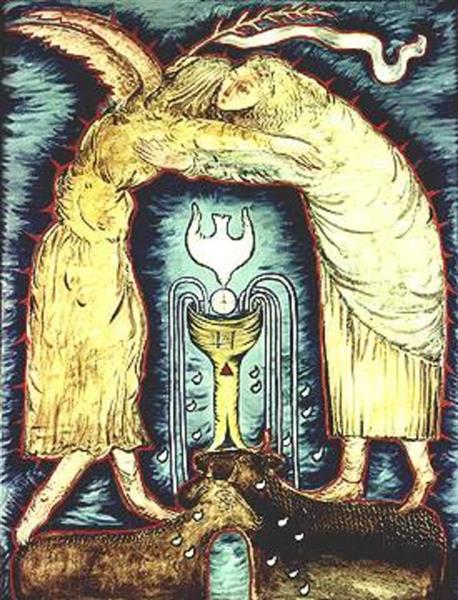
This residue of peace wore off quickly. When I grasped the implications of what I now felt commitment to, I panicked. Extraverted thinking as trickster sprang up from the depths. Suddenly I was running down the mental cubby hole where all the things I was going to have to sacrifice were screaming at me: loving relationships with my wife and children; long term friendships with those who could not or would not understand; and the costs, drama, and pain of medical transition. It was the abject abandonment of a reputation and persona that my introverted thinking function had worked a lifetime to create and to substantiate. In the blink of an eye, my eternal child had to be banished from the comforts of home if something new were to be born. Shumate (2021) said, “It is the eternal child’s illusion of omnipotence that blocks anima integration” (p. 104).
The symbolism and images in the dream ranged from the sublime to the ridiculous, but the exaggerated monumentalism seemed necessary to draw me a true picture of my position. Psyche was using multiple tools to get my attention: the sacred, the endearing, the paradoxical. They were all there in structure. It was a larger-than-life experience because something radically life-altering was pointing me toward a profound and consequential sacrifice. When I spent time with the dream, I knew that I was at the edge of an unfathomable abyss. Whatever I thought I was carrying in my pregnancy, if I said “yes,” as I believed I had, to carrying it to term, the life I had known was shattered. Driving back from Santa Fe, I sobbed for hours. These were the tears of profound anguish, shed for things that had been and things that were yet to come.
End of Part I: Descent
Part II, Ascent, to appear soon
References
Beebe, J. (2004/2017). Understanding consciousness through the theory of psychological types, In J. Cambray, & L. Carter (Eds.), Analytical psychology: Contemporary perspectives in Jungian analysis (pp. 83-115). Brunner Routledge.
Giannini, J. (2004). Compass of the Soul. Center for Applications of Psychological Type.
Hillman, J. (1985). Anima an anatomy of a personified notion. Spring Publications.
Hillman, J. (2013). Senex and puer. Spring Publications.
Jung, C. G. (1921/1971). General description of the types (R. F. C. Hull, Trans.). In H. Read et al. (Eds.), The collected works of C.G. Jung: Psychological types, (Vol. 6). Princeton University Press.
Jung, C. G. (1935/1955). The Tavistock lectures (R. F. C. Reid, Trans). In H. Read et al. (Eds.), The collected works of C.G. Jung: The symbolic life: Miscellaneous writings, (Vol. 18). Princeton University Press.
Jung, C. G. (1952/1956). The dual mother (R. F. C. Reid, Trans). In H. Read et al. (Eds.), The collected works of C.G. Jung: The symbolic life: Miscellaneous writings, (Vol. 5), Princeton University Press.
Jung, C. G. (1954/1959). Archetypes of the collective unconscious (R. F. C. Reid, Trans). In H. Read et al. (Eds.), The collected works of C.G. Jung: The symbolic life: Miscellaneous writings, (Vol. 9i). Princeton University Press.
Jung, C. G. (1961/1963). Memories, dreams, reflections (A. Jaffé, Ed.) (R. & C. Winston, Trans.). Random House.
Rilke, M. (1954). Letters to a young poet (Herter Norton, Trans.). W.W Norton & Co.
Shumate, C. (2021). Projection and the personality development via the eight-function model. Routledge.
Whitmont, E. (1982). Return of the Goddess. Crossroad.
Images
Balint, E. (1961). Vision at Rouen. Retrieved from wikiart.org
Fergusson, J. D. (n.d.). Hortensia. Retrieved from wikiart.org
Hume, G. (1999). Water painting. Retrieved from wikiart.org
Michaux, H. (n.d.). Untitled 2. Retrieved from wikiart.org
Milev, I. (1925). Ahinora. Retrieved from wikiart.org
Trubine, V. (1989). Adoration of the newborn fear. Retrieved from wikiart.org



